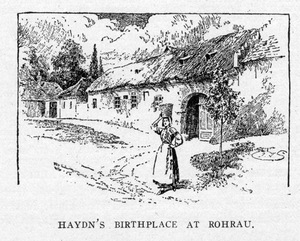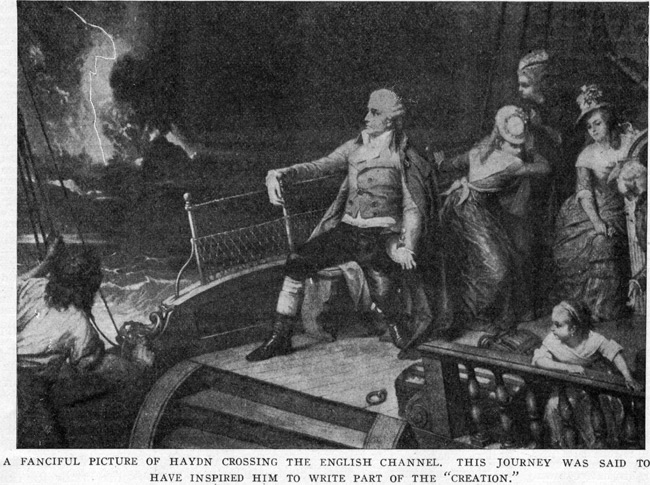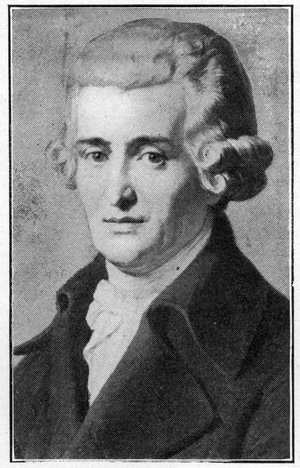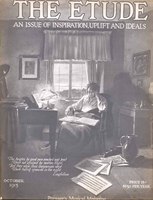Change comes slowly to the pleasant little country villages of Europe. Many, indeed, stand to-day very much as they stood nearly two hundred years ago. As we observe their rustic simplicity we can imagine how much more provincial must have been the life in such a little town as Rohrau, in Austria, at that day when the Postillion took the place of the telegraph and likewise that of the newspaper. Rumors of war were long in coming. Culture was slow in developing. The great concern of the townspeople at that day was doubtless to be let alone. They cared little whether the Turks were attacking Vienna so long as a Sobieski was there to save the city. Whether the emperor’s son succeeded to the throne of Spain was of far less importance to them than their own tranquillity and prosperity. Battles might wage furiously in France if peace prevailed in Croatia. It sufficed them to know that Austria was in the fore-front of the nations of the world and that somewhere in the empire great men were paving the way for an education and a culture that some day was to make life easier and happier for the people.
There has been a surprising amount of dispute regarding the exact ancestry of Haydn. Some have claimed that he was originally of German stock, but the extensive investigations of W. A. Hadow, M.A., point to the fact that while his father might have been of Slav origin, his mother was a Croat. The name was doubtless Hajdin in its original form. This name and the derivatives Hajdenic and Hajdinovic are still heard in Croatia. Haydn’s father was a wheelwright and also the Parish Sexton. He played the harp, but “did not know a note of music.” Haydn’s mother was a typical Hausfrau of the peasant class. She had been a cook in the family of a nearby count, and although plebeian by birth was said to have had refined tendencies. Haydn was always greatly devoted to her.
HAYDN’S BIRTHPLACE.
Haydn was born at Rohrau, near Prügg, in Austria, Hungary (Croatia). The house in which he was born has been washed away by floods and since that time two other houses, said to be replicas of the original, have been erected upon the site. The district in which Rohrau is located is “low and damp” and quite different from that inspiring Austrian city of Salzburg in which Haydn’s friend and pupil, Mozart, was born. Haydn was inclined to boast of his humble origin and was delighted when he was called upon to view a monument to him erected near his native town.
HAYDN’S EARLY TRAINING.
In Haydn’s home there was much impromptu singing when his father played the harp. Little Haydn is said to have imitated the fiddling of the local schoolmaster, using instead of a violin a stick of wood. One day a relative visited the Haydns and was astonished to see how well the little fellow kept time upon his make-believe fiddle. The relative happened to be a school teacher and insisted upon taking the child away with him in order to oversee his early musical training. Accordingly, Haydn set out with his new found friend, Johann Mathias Franck, and settled down at Hainburg on the Danube. Franck taught him to play the violin and the harpsichord and at the age of six Haydn was sufficiently advanced to sing masses in the village church. Once he was asked to play a drum in a local procession. He was too tiny to carry the instrument, and accordingly it was tied to the back of a hunchback who marched ahead of him.
In 1740, Reutter the Capellmeister of St. Stephen’s Cathedral in Vienna, visited Hainburg and after hearing Haydn sing, insisted upon taking him back to Vienna to become a chorister in the famous church. There Haydn became a member of the Choir School (Cantorei) founded in the early fifteenth century. Here he was to receive very meagre board and lodging, but a common school education, plus special training in violin, clavier, singing, Latin and religion. As Haydn’s mother was very anxious to have her son become a priest the latter was very gratifying to her. Haydn was neglected and abused by Reutter. The composer declared in later life that he had had no more than two lessons in composition from the severe Capellmeister.
 However, the routine work of the choir school and the constant desire to hear better music and make better music led the boy to study by himself. There is no better example of self-help than the struggles of little Haydn at this time. He begged six florins from his father and with them he purchased Fux’s Gradus ad Parnassum and Mattheson’s Volkommener Capellmeister. It would be difficult to imagine two duller, drearier, drier musical text-books than these. In his spare moments he found time to study these works so thoroughly that he produced results which surprised many.
However, the routine work of the choir school and the constant desire to hear better music and make better music led the boy to study by himself. There is no better example of self-help than the struggles of little Haydn at this time. He begged six florins from his father and with them he purchased Fux’s Gradus ad Parnassum and Mattheson’s Volkommener Capellmeister. It would be difficult to imagine two duller, drearier, drier musical text-books than these. In his spare moments he found time to study these works so thoroughly that he produced results which surprised many.Haydn was a youth of great vitality and high spirits. The story is told of Haydn cutting off the pigtail of one of the other boys in the choir. Haydn was now seventeen years old and his voice had changed. Accordingly, he lost the favor of Reutter, who took this opportunity to discipline him by turning the youth out into the street without funds of any kind.
HAYDN’S MISERABLE YOUTH.
Penniless, threadbare, hungry, Haydn wandered the streets of the great city that now boasts of him as one of her masters. Misery loves company, and Haydn fell into the comradeship of one Spangler, who was a little better off than the young composer. Spangler was a tenor with a very slender income and a wife and a child to look after. Nevertheless, he invited the unfortunate Haydn to share his garret with him, and the garret proved a home of the master during the most critical moments in his life. Friends gradually came to his rescue. A merchant named Buchholz loaned Haydn 150 florins. Later Haydn paid this back and in his will left 100 florins to the granddaughter of the same Buchholz. Haydn then indulged in the luxury of having a garret of his own, where, with the company of a wornout clavier and surrounded by a cook, a footman and a journeyman printer, he claimed to be “too happy to envy the lot of kings.”
Metastasio, the librettist and poet, lived in more pretentious apartments in the same building with Haydn. Hearing of the young man’s plight he secured him the position of teacher to the daughter of a wealthy Spaniard. Haydn took up his abode in the home of the young lady and continued in this position for three years. All the time he was busily engaged in composing, and while some of his compositions appear to be trite and stilted they nevertheless won his own approbation late in life. Metastasio introduced Haydn to Porpora, then one of the most distinguished musicians in Vienna. Haydn was glad to become the valet of Porpora and even blacked his shoes and did other menial work. Although he received no regular musical training from Porpora, there were educational crumbs continually dropping from his table and Haydn devoured these. His greatest advances, however, were made through self-study of the works we have mentioned hitherto.
Haydn was devoted to the works of Emanuel Bach, and the latter apparently appreciated the attention the younger musician paid to his works, rather than selecting the works of his illustrious father, Johann Sebastian Bach. Haydn followed the style of Emanuel Bach in some of his musical compositions. In 1751 he composed the music for an opera called The New Crooked Devil. This was successfully produced, but the score was lost and has never been recovered. His reputation accumulated rapidly and appointments and commissions followed in quick succession. Accordingly he felt justified to ask from two to five florins per month for instruction. Just what Haydn’s income was at this time is hard to discover, but he was apparently not afraid to get married in 1760 when his salary was little over one hundred dollars a year, with board and lodging. Haydn’s bride was one Anna Maria Keller, the daughter of a barber. She was three years older than Haydn. Her taciturnity and extravagance are said to have been far less annoying to the indulgent, happy master, than his wife’s disconcerting custom of using her husband’s fresh-made manuscripts for curl papers or as platters for her tarts.
WITH THE ESTERHAZYS.
Haydn’s patron, Count Morzin, became financially embarrassed and the rising composer was obliged to seek another protector. This he found in the person of Paul Anton, reigning prince of the wonderful house of Esterhazy. Prince Esterhazy was a brilliant soldier, an intense patriot and an ardent devotee of all the arts and sciences,—particularly music. Haydn went to the Esterhazy palace in 1761 and remained in the service of the family for thirty or more years. His contract with the Esterhazys seems in this day a very amusing document, but it was no doubt very necessary in the time of Haydn. Haydn is enjoined to be temperate with his musicians and to see that they appear in white stockings, white linen, powdered and either with a pigtail or tie-wig. He is reminded that he is expected to set an example to the other musicians by refraining from vulgarity in eating, drinking and conversation. The said Joseph Heyden (Haydn) is commanded to appear in the ante-chamber of the Prince every morning and every afternoon to inquire whether his Highness will require the services of the orchestra. The said Joseph Heyden is ordered to instruct the female vocalists and also practice himself upon the various instruments he is expected to play. Haydn is also to receive a salary of four hundred florins, paid quarterly, and to have his meals at the officer’s table.
Haydn had an excellent little orchestra at his disposal and had a glorious opportunity for trying his own compositions. Though his salary was small at the start it was eventually raised to 1400 florins and this was continued as a pension after he left the service of the Esterhazys. While Haydn was nominally Vice Capellmeister and Joseph Werner was the real Capellmeister at the first, Haydn was virtually the head of all the musical undertakings at the Palace.
Upon the death of Prince Paul in 1762 his brother Nicholas succeeded him. Nicholas was known as “The Magnificent” and the Esterhazy palace became more brilliant than ever. Prince Nicholas was a competent player upon the baryton (an intrument (sic) resembling the viola-da-gamba) and took delight in playing with his men. This accounts for the one hundred and seventy- five compositions which Haydn wrote for this almost obsolete instrument. Haydn was continually obliged to write music for important functions and he seemed to be willing to produce anything from a cantata or an operetta to a symphony or a Te Deum. His long service to the Esterhazys terminated with the death of Prince Nicholas in 1790. Prince Anton, who succeeded Prince Nicholas, had little love for music and dismissed the whole body of musicians, singers and actors retained at the palace, except a few connected with the religious services of the chapel. This was really a stroke of good fortune for Haydn, who had become very celebrated by this time and who longed for broader fields in which to exploit his works.
HAYDN IN LONDON.
In 1791 Haydn went to London under the management of the violinist, John Peter Salomon. Haydn was to receive $1500.00 for six symphonies,—$1000.00 for the copyright of them, $1000.00 for a benefit concert and $1000.00 for twenty new compositions. This was quite a fortune in those days, but it must be remembered that Haydn was the most celebrated composer of his time.
The journey to London took over fifteen days. It is believed that on the way Haydn met Beethoven at Bonn. In London Haydn was fêted like a prince, but he soon tired of the round of dinners and honors. The first concert was a huge success, but the London public, accustomed to great things, ere long became tired of “too much of a good thing;” accordingly Haydn produced his Surprise Symphony, with its explosive fortissimo, following a long pianissimo. “There all the women will scream,” exclaimed Haydn and surely enough the Surprise Symphony became the talk of the hour.
Haydn was not to be allowed to escape without a degree, and Oxford made him Doctor of Music. His exercise for the degree was the Canon cancrizans a tre, on the words Thy Voice, O Harmony, is divine.
A PORTENTOUS MEETING.
On his way back from London, in 1792, Haydn had a meeting with Beethoven which proved very fortunate for the latter. Beethoven wrote a cantata for a dinner given by the Band of the Elector. Haydn was immensely pleased with it and induced Beethoven to go to Vienna, whither he went in November of the same year. In Vienna Beethoven became a pupil of Haydn, paying him about twenty cents a lesson. Beethoven was first, last and always an iconoclast. Haydn, then well along in years, was steeped in conventions. He could not understand his vehement pupil, who was never content unless he was hurdling strict rules. Haydn became disinterested and Beethoven in later years is quoted as saying, “I never learned anything from Haydn,—he never would correct my mistakes.”
IN LONDON AGAIN.
Haydn made a second trip to London, in 1794, this time taking with him his faithful servant and copyist, Johann Elssler, to whom he bequeathed the sum of six thousand florins. This second visit, like the first, was a huge success. He was lionized everywhere and was even invited by the Queen to make his home at Windsor. The six new symphonies he wrote for the Salomon concerts were received with great favor, some numbers being interrupted by the applause of impressionable Frenchmen, who were promptly condemned by the press. Haydn, according to the custom of the times, conducted seated at the pianoforte. Upon his return it was found that he had earned in various ways about $6000.00, a very large sum in 1795.
Once more Haydn found himself at Esterhazy under the protection of a new prince. Despite his increasing years he was still a productive composer. When Nelson visited Eisenstadt in 1800, Haydn wrote a Mass in his honor. Nelson asked for the composer’s pen and upon receiving it presented him with his own watch in return.
THE EMPEROR’S HYMN.
In 1797 Haydn wrote the Austrian Hymn known as Gott erhalte-unser Kaiser (God save the Emperor.) The Emperor was so delighted that he presented Haydn with a gold box bearing a relief portrait of his imperial majesty. Hadow has shown how the tune that Haydn employed bore a very close resemblance to certain parts of Croatian melodies which Haydn, through his superior skill as a musician, ennobled into a great national hymn, possibly one of the best of all national hymns. Haydn was much attached to this hymn and frequently played it for his own delight.
TWO GREAT ORATORIOS.
Haydn’s visits to England had given him an opportunity to estimate the popular value of oratorio. He heard Handel’s Messiah many times and was anxious to compose a similar work. The enterprising Salomon provided him with a very weak libretto which resulted in the composition of The Creation. It was first produced by an amateur chorus in Vienna, April 29th, 1798. One half of the first edition was purchased by English admirers. The Creation was given for the first time in London in 1800. In the same year it was given in Paris by artists who became so enthusiastic that they presented Haydn with a medal of appreciation. The aged composer modestly thanked them for strewing flowers on the brink of his grave. The Creation was performed in America for the first time by the Moravians at Bethlehem, Pa., 1811, though whether the work was given complete we cannot say. The first known complete performance was given by the Handel and Hayden Society of Boston, 1819. The success of The Creation induced Haydn to write The Seasons, a work of lighter calibre, but surprisingly fresh and vigorous for a man of sixty-eight. The Seasons was first produced in April 1801.

HAYDN’S LAST HOURS.
The strain of writing The Seasons proved very great for Hadyn (sic). The composer grew gradually weaker and weaker. On his seventy-sixth birthday a performance of The Creation was arranged in his honor. Haydn was taken to the hall in the carriage of Prince Esterhazy and carried to his place in an arm chair. Seated among nobles and notables, protected from the March drafts by the scarfs of Princesses and Duchesses, Haydn greeted an audience which rose to pay him reverence. When the venerable musician heard the chorus, “And there was light,” applauded wildly by the audience, he raised his hand and pointing to the skies said, “Not I, but a power from above created that.” Hummel and Beethoven were there. At the end Beethoven knelt and kissed the hand of his aged master. Haydn, in passing out, bade the bearers of his chair pause long enough on the threshold of the stage door to raise his hands and cast a last blessing to the orchestra.
In 1809 the French occupied Vienna by military force. Haydn, intensely patriotic, was very much depressed by this. On the 26th of May he had a sinking spell and although very feeble asked to be carried to the piano, where he played the Emperor’s Hymn three times. He died five days later. The great respect with which he was held may be estimated by the fact that funeral services were conducted in several different churches, the officers of the invading army attending many of them.
HAYDN’S APPEARANCE AND PERSONALITY.
Art is kind to the great. Few people would detect in the average portrait of Haydn a man whose features were described by many as “repulsive.” Haydn was disfigured not only by the results of a bad case of smallpox, but had in addition a polypus which altered the shape of his nose, and a very thick underlip which engaged the attention of all who saw him for the first time. He was so dark that he was sometimes dubbed “The Moor.” His eyes, however, were so kindly and so merry that they softened his entire expression. In fact he has gained the reputation of being the merriest of all the great masters. The brightness and good cheer which characterizes so many of his compositions was but a reflection of the man. He enjoyed life hugely. Good jokes entertained him immensely and he loved to converse with attractive women. He was very pious and very generous,—rewarding his old friends and servants liberally in his will.
HAYDN AS A COMPOSER.
Haydn wrote so continuously that a catalogue of his complete compositions would fill many pages. Of his 125 symphonies the best known are perhaps the Farewell, Toy, Oxford, Surprise and Military. The symphonies are finely arranged for piano duet and make excellent teaching material for students in the fifth, sixth and seventh grades (grading by ten). Haydn’s seventy-seven string quartets are especially fine. While his pianoforte concertos and trios are rarely played, his pianoforte sonatas are invaluable as teaching material. The nine violin concertos and the four violin sonatas are less well known. Three oratorios, fourteen masses, and numerous other works for the voice remain. His operas and operettas are practically obsolete and are in fact of comparatively little merit in this day. Probably his greatest achievements were the advances in instrumentation he brought about by means of constant daily experimentation in effects obtained by the use of different combinations of instruments, and also the establishment of what has come to be known as the “Haydn-form”— that is, the general plan of the first movement of the sonata. While this form was in a measure anticipated in the compositions of C. P. E. Bach, D. Scarlatti, Corelli and others, it remained for Haydn to bring symmetry and clearness to the plan.
HAYDN’S FRIENDS.
A man of Haydn’s jovial disposition would naturally have many friends, apart from those already mentioned. First of all we must note, his brother Michael, who was also a musician of no mean ability. Haydn left him 4000 florins in his will. Haydn carried on a very interesting correspondence with one George Thompson, a great friend of Burns, who was anxious to have Haydn make settings for Scotch National Songs. Thompson paid over one thousand dollars for settings of some two hundred and fifty songs. Of all Haydn’s friends Mozart was the dearest. He is believed to have met him first in the winter of 1778. That Mozart profited by his friendship with the older master quite as much as Haydn gained from the brilliant genius of Mozart is very obvious. Haydn once exclaimed, “It enrages me to think that the unparalleled Mozart is not engaged at any Imperial Court! Forgive my excitement, I love the man so dearly.” The great veneration Mozart had for Haydn and for his music is expressed in the term “Papa Haydn” which to this day clings to his name when it is heard in musical circles.
A HAYDN PROGRAM.
1. Piano Duet. Theme and Variations from Symphony No. 20. Grade 4.
2. Piano Solo. Sonata No. k in D. Grade 6. Or, Andante from Surprise Symphonie, transcribed by Saint-Saens. Grade 7.
3. Vocal Solo. My Mother Bids Me Bind My Hair. Grade 4.
4. Violin Solo. Serenade in C (from Quartet in F). Grade 3.
5. Piano Solo. Four Gems From Haydn. Grade 3. Or, Andante and Variations in F Minor. Grade 6.
6. Piano (Six Hands). Gypsy Rondo. Grade 4.
7. Piano Solo. Sonata in E Flat Major. Grade 6. Or, Largo from G Minor (String Quartet). Grade 4.
8. Vocal Solo. With Verdure Clad (Creation) Grade 7.
9. Violin Solo. Minuet in E Flat (arr. by Burmeister). Grade 4.
10. Chorus. The Heavens are Telling; or, Lo! My Shepherd’s Hand Divine. Grade 8.
BOOKS ABOUT HAYDN.
Life of Haydn, by Louis Nohl, translated from the German by George P. Upton; Haydn, by J. Cuthbert Hadden; A Croatian Composer, Notes Toward the Study of Joseph Haydn, by W. H. Hadow: Joseph Haydn, sein Leben und seine Werke, by August Riessmann; Joseph Haydn, Biographie, by C. F. Pohl.




